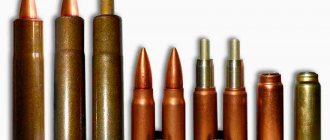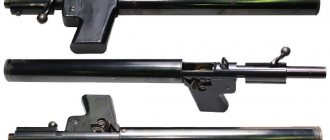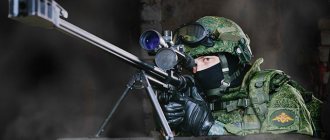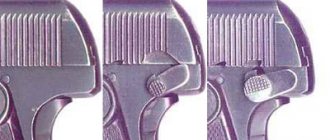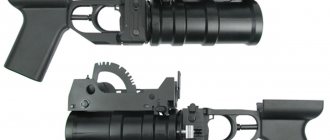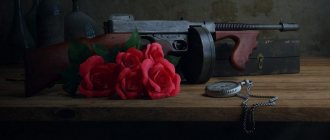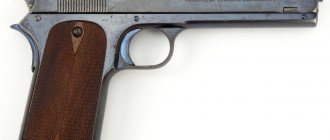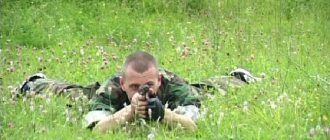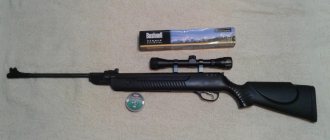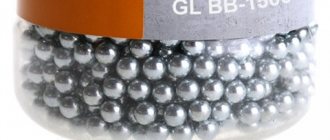Silencers for AK -shaped ones occupy a special place in our assortment: these are one of the most purchased silencers (closed type DTK), they are often taken by both intelligence officers for official use on AKs, and owners of civilian weapons for rifles built on the basis of AK: Saiga MK , VPO-133, VPO-136, VPO-209 and others.
Since the most popular muffler for AKs was and remains the classic PBS, we would like to talk about the Rotor 43 muffler in comparison with the PBS for AKs. It’s worth mentioning right away that the Soviet PBS is not just some product for us, but an integral part of weapons culture, part of history, an example of engineering resourcefulness, and we will try to cover this topic as adequately and unbiasedly as possible.
Purpose
The tactical machine gun silencer (hereinafter referred to as the ATG silencer) is designed to reduce the sound and fire of a shot when firing from 5.45 mm Kalashnikov AK74, AKS74, AK74M, AK105 assault rifles;
5.56 mm Kalashnikov assault rifles AK101, AK102 and 7.62 mm Kalashnikov assault rifles AK103 and AK104. The silencer is installed on the 5.45 mm modernized Kalashnikov AK74M assault rifle in accordance with Figure 1 (installation on 5.45 mm Kalashnikov assault rifles AK74, AKS74, AK105; 5.56 mm Kalashnikov assault rifles AK101 and AK102 and 7.62 mm assault rifles Kalashnikov AK103 and AK104 are similar).
Figure 1 — General view of the 5.45 mm modernized Kalashnikov AK74M assault rifle with a silencer
1 - 5.45 mm modernized Kalashnikov assault rifle; 2 — tactical automatic silencer
When installing a silencer on AK103 and AK104 assault rifles and using a 6CH7 shutter in the silencer, silent and flameless firing of 7.62 mm “US” cartridges is possible.
Advantages of this PBS-1 layout
- During manufacturing, the technology of coaxiality of all threads is observed, so that the PBS during installation is coaxial with respect to the AK thread.
- The end washer is threaded, which allows it to be changed.
- And easy to clean layout.
Is the model of the PBS-1 muffler legal?
The PBS-1 model, which we offer to buy in our store, is not the main element of a firearm. It's more of an accessory. The muffler design cannot cause harm to others. And adding it to a cold or deactivated weapon will in no way turn it into a firearm.
Thus, you can buy a mock-up of PBS-1 for AK completely legally, without any special licenses or permits.
Buying PBS-1 for AK at a competitive price is the dream of any collector who wants to assemble a complete set of accessories for his own cold or deactivated Kalashnikov assault rifle.
From us you can Buy a Model of the PBS-1 Silencer (Silent Shooting Device) cheaply . Before placing an order, you can clarify the price and contents of the product by phone or by e-mail specified on the Contacts page or the feedback system (at any time convenient for you).
Delivery in Moscow by courier. Delivery within Russia - we send by Russian Post and Transport companies!!! Purchased without any permissions or licenses!
Design and principle of operation of the muffler
The silencer is a muzzle device installed on the machine gun instead of the standard muzzle brake (flame arrester) and is structurally designed from successively arranged chambers formed by separator partitions and a casing that prevent the direct outflow of powder gases after the bullet leaving the barrel.
The reduction in sound level occurs due to a significant decrease in the pressure of gases flowing from the muzzle device.
During a shot, powder gases following the bullet along the bullet channel of the silencer are repeatedly cut off from the bullet by separator partitions, expand and mix, filling the silencer chambers, which changes the direction and speed of the gas flows, which leads to a decrease in the pressure of the powder gases and a slower flow from the muffler into the atmosphere.
The reduction in the flamingness of a shot from a machine gun with a silencer occurs due to the combustion of powder particles in the expansion chambers and partly due to the cooling of the powder gases on the surface of the chambers.
During the first shot, a muzzle flame may occur due to the burnout of the air inside the muffler.
The silence of a shot from an AK103 (AK104) assault rifle with a silencer is ensured by the design of the silencer and the use of 7.62 mm “US” cartridges, which have a subsonic muzzle velocity. To ensure automatic operation when firing 7.62 mm US cartridges, a seal (rubber plug) is installed in the muffler.
When fired, the bullet exits the barrel bore and pierces the rubber seal of the seal. The rubber, compressing after the bullet passes, prevents the breakthrough of powder gases into the muffler body. The powder gases that managed to break through after the bullet enter the expansion chambers formed by the separator partitions and the casing, expand, lose luminosity, speed and do not create sound. Cut off by the obturator, the gases create in the barrel bore the pressure necessary for the operation of the machine gun.
Figure 2 – General view of the muffler and its components
1 – casing assembly; 2 – separator; 3 – head; 4 – support; 5 – shutter
Muffler design for AK Rotor 43
the muffler for the AK based on specially shaped partitions that form chambers inside the muffler housing. The main idea is that powder gases fall into the “trap” by swirling around the partitions.
It’s difficult to explain in words, it’s better to look at an illustration from patent documents:
This is why Rotor 43 mufflers have such high efficiency with adequate external dimensions. This principle was developed and patented by D.V. Gritsenko. - founder and owner with the call sign Rotor 43 during his service in the special forces. The design of the muffler for the AK Rotor 43 does not have a seal or other parts that come into contact with the bullet and are subject to wear, or at least somehow affect the flight of the bullet, etc.
On the Internet you can find the opinion, also replicated by “armchair analysts,” that all Rotor 43 mufflers have the same filling. This is wrong. Even using the example of AK-shaped mufflers, you can see that for 7.62x39 there is one geometry of chambers and partitions, for 5.45x39 there is another, for .366 TKM there is a third. Or can you imagine that we use partitions for .366 caliber for 5.45x39?! In the case of the geometry of chambers and partitions made according to the Rotor 43 principle, a simple change in the internal diameter is not enough, since a change in caliber in any case entails a change in geometry: after all, our mufflers do not have flat washers. In addition, modern mufflers for AK Rotor 43 are manufactured with a gas discharge system integrated into the first chamber, which makes them gas-unloaded. There is a corresponding article about what a gas-loaded muffler for AK is and not only. The AK silencer Rotor 43 is designed to work with any cartridges that are approved for each specific AK variant.
The use of special subsonic cartridges with less powder and heavier bullets is not required (and where would civilians legally obtain such ammunition...).
Design and operation of muffler components
The muffler in accordance with Figure 2 consists of the following main parts: casing assembly, separator, head, support. For silent and flameless firing from AK103 and AK104 assault rifles with 7.62 mm US cartridges, it is necessary to install a shutter in the silencer.
The casing assembly is designed to accommodate the separator and is a hollow cylinder.
On the outer surface of the casing there is a thread for connecting the casing to the head, and also a latch in the form of a leaf spring is attached with two screws, which serves to prevent the casing from self-unscrewing.
Figure 3 — Casing assembly
1 – casing; 2 – latch; 3 – screw; A – thread
The separator is used for cutting and mixing powder gases and consists of 11 funnels, 10 partitions, 33 bushings, a rear ring, a front ring, fastened together by three rods.
In the front and rear rings, funnels and partitions of the separator there are central holes for the passage of bullets, which when assembled form the bullet channel of the silencer.
Figure 4 - Separator
1 – rear ring; 2 – funnel; 3 – partition; 4 – bushing; 5 – front ring; 6 – rod; 7 – nut
The head is used to place a support inside it (or in the version of the ATG.Sb-01 muffler, a support with a seal), closing the casing assembly and securing the muffler to the machine. The head has a thread for screwing onto the casing, a longitudinal groove for the shutter lock, recesses for engaging the latch and a pipe, which has a thread for screwing the muffler onto the machine's front sight block and cutouts for engaging with the lock on the machine's front sight block.
Figure 5 - Head
A - thread for connection to the casing; B - thread for screwing onto the front sight block; B - longitudinal groove for the shutter lock; G - recesses for the latch; D - cutouts for engagement with clamps
The support serves to center the muffler relative to the cylindrical protrusion of the front sight block when installing the muffler on the machine gun and placing the shutter (for silent and flameless shooting from AK103 and AK104 machine guns with 7.62 mm “US” cartridges). The support has two chambers inside. A larger one for placing a shutter in it and a smaller one for basing the muffler on the machine's front sight block.
Figure 6 - Support
A - chamber for mounting the muffler on the front sight block; B - chamber for placing the shutter
The shutter is used to cut off powder gases during silent and flameless firing from AK 103 and AK104 assault rifles with 7.62 mm “US” cartridges and is a rubber stopper enclosed in a metal clip with a latch. When installing the shutter into the muffler, the latch fits into the longitudinal groove of the head and ensures a constant position of the shutter in relation to the barrel of the machine gun when firing.
Figure 7 - Obturator
1 - wallpaper; 2 - plug; A – retainer
You can buy the PBS-4 muffler only from us!
If you want to become the owner of this rather rare product on sale, then hurry up - you can only buy the PBS-4 muffler from us, and the supply is seriously limited!
This product, although it cannot be used to equip a civilian with a real Kalashnikov assault rifle chambered for 5.45x39 mm, is perfect for installation on any weight-and-size model or a cold AK-74 assault rifle.
This product has a fairly high level of quality and is an original product produced by the Izhevsk Machine-Building Plant, which previously operated as a defense enterprise. An expert assessment allows us to evaluate the operational condition of the described product as ideal: the product is free of any defects, both structural and visual. If you really need a PBS-4 muffler, then you will certainly pay close attention to our offer. The high quality of the product and a fairly reasonable price are the main reasons not to think twice about purchasing.
New in blogs
There is no need to discuss the importance of silent weapons. Unfortunately, the experience of communicating with fighters of current special forces shows that many of them do not know the specifics of operation, the rules for testing combat and leading to normal combat, the advantages and disadvantages of certain silent systems. And one of the reasons for this is the almost complete absence of specialized literature in the troops. And in the existing one, for example in the “Service Manual for PBS”, there is not a single shooting table! The purpose of this article is to provide the necessary basic information about the “Silent and flameless firing device for 7.62 mm modernized Kalashnikov assault rifles (AKM and AKMS).”
PECULIARITIES
In the weapons system of the Ministry of Defense and the Ministry of Internal Affairs of Russia, silent systems are currently represented quite widely. These are the knives NRS-1 and NRS-2; pistols S-4M, MSP, PSS, PB, APB; long-barreled weapons AKS-74UB, AS, VSS, VSK-94 and a great variety of submachine guns. They all have their advantages and disadvantages, but a special place is still occupied by the “veteran” - the AKM with PBS, and this article is dedicated to it - the AKM with PBS-1.
Silent rifle-grenade launcher complex
Its first and main advantage is the mass availability and availability of weapons and the US 7.62×39 cartridge. An AKM with PBS costs 5 times less than the AS Val (6-P-30), and the US cartridge costs 5–10 times less than SP-5, SP-6 and PAB-9!.
The second advantage is the simplicity of the device, the highest reliability and operational strength.
And thirdly, only the owner of an AKM with PBS always has the opportunity to use normal ammunition, which will greatly facilitate fire combat. The combination of AKM with PBS (US cartridge) and the GSN-19 silent grenade launcher (BMYA-31 round) forms a unique silent rifle-grenade launcher complex! Of course, AKM with PBS also has disadvantages. Including: the need to periodically bring the weapon into normal combat due to the replaceable element - the shutter, increased weight and dimensions and somewhat worse accuracy and acoustics compared to other models.
EXPLOITATION
Bringing an AKM with PBS to normal combat should be carried out more carefully than ever and begin with bringing the machine gun to normal combat using ordinary cartridges in accordance with the requirements of the NSD (D = 100 m, Pr-3, target - a black rectangle 35x25 cm, aiming point - the middle of the lower edge). The point is to set the normal position of the front sight, check the weapon for accuracy (R100 =< 7.5 cm) and, if possible, select the most accurate machine gun. Next, a PBS with a tightly (!) screwed-on body is screwed onto the machine gun (all the way) and a special sighting bar is installed. Don't forget to replace the PS cartridges with US ones!
US cartridges of different years of manufacture
Before bringing the weapon into normal combat with the PBS, it is necessary to fire 2-3 shots of US cartridges into the air to form a bullet channel in the seal. On a special sighting bar the following are installed: rear sight at “0”, sight at “1” on the bottom side , teeth of the clamp heads at “3”. The aiming point is also CT. The STP is brought to the CT: vertically by changing the number of teeth (a smaller number is lower than the STP, and vice versa), horizontally - by moving the rear sight (STP to the right of the CT - move the rear sight to the left, and vice versa, the cost of one division is 20 cm per 100 m , one click – 3.3 cm). Some machine guns do not engage in normal vertical combat. Replace the shutter and repeat shooting; if it does not align, then begin to pull the STP towards the CT by screwing or unscrewing the front sight (at 100 m, one turn moves the STP by 20 cm). Remember that the scope settings for a regular bullet will be disrupted. Decide for yourself what is more important for the business. It is better, of course, to replace the machine.
Sighting strips for PBS and PBS-1
The most accurate way to bring an AKM with a PBS to normal combat is at a remote point (300–400 m) with measuring the range of the DKRM or LPR and making accurate wind and temperature corrections. Write the number of teeth and the amount of rear sight displacement after zeroing with PBS on the inside of the machine belt loop or a piece of adhesive plaster glued to the butt - it will be useful if there is a need to shoot supersonic cartridges, and then again with US. Do not unscrew the head of the device (only the body with the shutter), the rear sight is at “0”, move the teeth away from the sectors of the sight. The transition to the US cartridge is carried out by installing the “native” shutter and screwing the housing onto the head, moving the sighting bar settings under the PBS. No combat check is needed.
Don't confuse cartridges! A shot with a supersonic cartridge through a PBS with an “unfired” seal threatens to tear off a piece of the seal and destroy several partitions of the separator. Fired no more than 200 rounds before replacing the shutter (6 magazines plus 20 rounds to bring it to normal combat). The suitability of a seal, the amount of which is unknown, can be checked simply - whether the cleaning rod fits into the hole in the seal or not.
There is a legend about the rapid aging of the seal. At the end of the 1990s, one former republic of the USSR sold to another former, somewhat more southern, large batch of US 7.62×39 cartridges, which had been lying in warehouses for more than 35 years ! So, when checking the accuracy of the ammunition and the durability of the shutter, I was unable to identify any deviations from the norm.
When operating an AKM with PBS, remember about the accelerated contamination of the receiver and moving parts when firing US cartridges. When firing, do not forget about the steep trajectory of the US bullet and determine the range to the target as accurately as possible. All the advantages of the AKM with PBS are most pronounced at night, so try to have an assault rifle with a rail and equip your weapon with NSP-3 or NSPU sights.
IMPROVEMENTS
RPK with PBS and PGO-7V
• Instead of AKM, it is better to use RPK with PBS, especially for counter-sniper combat, due to better stability and accuracy;
• It is better to install a PGO-7V sight on a weapon, rather than a PSO-1, due to the practical coincidence of the trajectories of the PG-7V grenade and the US bullet. The PSO-1-1 (with the “VSS-AS” marking on the drum) is also suitable, but these sights are rare in the military, although they can be found in hunting stores;
• A brass mesh is wound inside the separator onto the bushings between the partitions for additional cooling of the escaped powder gases. PBS, like any muffler, works better when cold. Therefore, it is better to shoot single shots. During intense shooting, cool the barrel and the barrel by wrapping it with a wet bandage. Yes, and 3-4 cubic cm of water poured into PBS significantly reduces the sound of a shot;
• Make a front shutter by clamping a piece of rubber cut from a car inner tube between the front end of the PBS body and the front ring of the separator - it also reduces the sound of the shot;
• Install a rubber shock absorber (oil-resistant, 3-4 mm thick, repeating the shape of the internal section of the receiver) between the heel of the return mechanism guide rod and the spring. This noticeably weakens the impact of the bolt frame on the rear part of the receiver, which reduces the clanging noise when the moving parts roll back (for reference, on the AKM the speed of the moving parts reaches 5 m/sec!);
• In the absence of a shutter or its extreme wear, use a package of four spent polyethylene wads of PG-7VM rounds; they are somewhat smaller in diameter than the standard shutter, but, well pressed with the head to the rear ring of the shutter, they work perfectly.
PERSPECTIVE
PBS disassembled
For special forces, it is quite possible to create a weapon with a barrel that is “clean” on the outside and a release chamber, which, rotating around the barrel at the shooter’s request, opens or closes the holes in the walls of the barrel to discharge part of the powder gases into an integrated silencer. This achieves a reduction in the initial speed of the bullet, and therefore a low noise shot when using a single cartridge. All this, in combination with a striker-fired trigger circuit, a semi-blowback bolt (as the least noisy and most convenient for a system without a gas engine), and a special weapon coating that dampens high-frequency sound vibrations, will make the dream of a special forces soldier come true.
And in conclusion, do not idealize silent weapons. Some try to get their hands on it at any cost, forgetting that weapons, like any tool, are needed in specific conditions. Due to the long flight time of the bullet, it is very difficult, and sometimes impossible, to conduct accurate fire from a silent weapon at emerging and maneuvering targets, especially at long ranges.
PS With some stretch, the tables can be used for shooting from VSS, AS and VSK-94.
SHOOTING FROM AKM WITH PBS: EXPERT COMMENT
Dmitry Shiryaev
When shooting from an AKM with a PBS, the average point of impact (SIP) in relation to the aiming point (AP) for a number of reasons can “float” so much that only a competent shooter can achieve good results. The article by Sergei Evtekhov provides a certain amount of knowledge for this. The article will also be read with interest by those who are simply interested in weapons and seek to expand their knowledge in this area. However, in our opinion, it would be nice to supplement some provisions of the article with the comments below, which do not at all reduce the usefulness of the article. Moreover, they are based on many years of experience of TsNIITochMash engineers who have been involved in the theory and practice of suppressing the sound of a shot.
1. When bringing a 7.62-mm AKM assault rifle with the PBS-1 silent firing device into normal combat, it should be remembered that the initial speed, and therefore the trajectory data of the bullet of the US (reduced speed) cartridge, significantly depend on the length of the weapon barrel and the degree of wear of the latter. The initial velocity of a US bullet is influenced to a greater extent than for a conventional bullet by the frictional force as the bullet moves along the barrel. Therefore, on a worn AKM barrel, the initial bullet velocity of the US cartridge increases so much that the scale divisions of the sight are not enough to bring the weapon to normal combat. Such weapons are not used in normal combat.
From the history of the creation of PBS
A significant contribution to the theory of designing muzzle attachments-mufflers was made by senior researcher, candidate of technical sciences A.S. Neugodov. He also developed a silencer for the PB pistol and modified the Stechkin pistol (APB) for low-noise shooting. For more than ten years, Neugodov led the development of a sound suppression system for 5.45 mm weapons, as a result of which he created and developed muzzle attachments for flameless and low-noise shooting for the AKS-74U assault rifle - PBS3 and PBS4.
2. As for the use of the 7.62-mm RPK (RPKS, RPK74, RPKS74M) machine gun with PBS, recommended by the author, the picture here is even worse. On a new barrel of these machine guns, the initial velocity of the US bullet is too low, and on a worn one it increases to 360 m/s or more, which is generally unacceptable, since when the initial bullet velocity exceeds the speed of sound, the suppression efficiency is sharply reduced. Regarding the 5.45-mm RPK74M machine gun, it should be noted that on this machine gun, firing cartridges with a US bullet is strictly prohibited. And for only one reason: US bullets of this caliber (black and green color of the nose) can get stuck in the barrel!
By the way, it was never possible to develop a silent firing system based on the 5.45 mm AK-74 assault rifle and the US cartridge precisely because of the long barrel. Many years of efforts in this direction resulted only in the creation of a silent complex based on the shortened AKS-74U assault rifle. Unfortunately, this excellent complex, which also includes a silent grenade launcher shot, was released only in a small series.
The average point of impact on an AKM with PBS-1 during firing on one shutter (up to 200 shots) deviates from the initial reduction to normal combat by approximately 200 mm for every 100 meters. So try to hit the chest target from three hundred meters!
3. Regarding the recommendations to use a homemade front seal, it should be noted that in this case the STP will “float” even more, and the dispersion will at least double. The American Ingram submachine gun with a silencer equipped with a front shutter was studied in sufficient detail at TsNIITochMash. It must be said that the range, accuracy and barrier penetration characteristics of this “overseas” model are negligible compared to any domestic analogue.
From the history of the creation of PBS
Work on the creation of PBS began in the second half of the fifties on the initiative of NII-61 employee L.I. Golubeva, majoring in electrical engineering. The US cartridge was developed under the leadership of the head of the ammunition department, Stalin Prize laureate B.V. Semin as a young engineer G.M. Tereshin.
In those days, there was no theory for designing muzzle silencers, and Golubev worked by intuition using the method of numerous tests. Only one was known as a prototype at that time - the BRAMIT (Mitin Brothers) wartime attachments. This nozzle had two rubber seals - at the inlet and outlet of the nozzle. Special low-velocity cartridges were also developed for shooting with this attachment. They differed in that their capsules were sealed with green varnish.
Golubev managed to achieve an acceptable effect of muffling the muzzle sound wave even without a rubber shutter, but he was still forced to use the latter, since the automation did not work without the shutter. But after installing the shutter, even with a relatively weak US cartridge, the impulse of the gas chamber turned out to be excessive, and the rollback speed of the moving parts was unacceptably high. To eliminate this phenomenon, a chamber was provided in the device, in front of the shutter, to discharge some of the gases.
To make it easier to clean the device, Golubev made it open along its axis into two halves, like a cigarette case.
To reduce the dispersion of bullets, an attempt was made to use seals with a pre-made central hole for the passage of the bullet. This reduced the dispersion, but the survivability of the shutter was reduced by almost half and this idea had to be abandoned. Later, when developing the production technology, they abandoned the muffler housing that could be opened into two halves. This greatly simplified and reduced the cost of its production.
4. The proposal to use homemade seals in the absence or wear of standard seals is unlikely to find practical application, since US cartridges are supplied with an excess of seals. The life of an already shot shutter can be extended by about 20 shots if it is clamped as tightly as possible in the device. We have repeatedly had the opportunity to verify this when testing silencers.
5. Recommending the use of the PGO-7V grenade launcher sight instead of the PSO-1, the author does not explain why this is better. In our opinion, it is possible to ensure sufficiently effective firing of US cartridges only by using the PSO-1 (regular optical), NSP-3 and NSPU (both night sights) recommended for this purpose. These sights have special rings for firing US cartridges. Using the PGO-7V grenade launcher sight is unlikely to give results of the same quality due to the lack of scales on this sight for firing US cartridges, and the trajectory differences between a grenade and a bullet are still noticeable.
6. In conclusion, it is proposed to create a special weapon with a pressure release chamber for firing with a single cartridge, a semi-free bolt, a hammer instead of a hammer, and a special noise-attenuating coating.
It should be noted here that there have been attempts to regulate the initial velocity of a bullet by discharging powder gases. This was done by developers who needed to test the functioning of experimental bullets at different speeds.
These attempts were unsuccessful. Firstly, it was not possible to reduce the speed within the required (including subsonic) limits. Secondly, shooting from a barrel with many holes for releasing gases was characterized by large dispersion. Further, to obtain acceptable results at super- and subsonic levels, bullets must differ significantly in weight, therefore, when developing bullets, US strives to increase their length and core weight.
Impact breaking was used in many experimental machines. In most cases, designers, due to the long stroke of the firing pin, tried to increase the time cycle of the automation and thus reduce the rate of fire.
From the history of the creation of PBS
Work on muzzle silencers in the USSR was intensified after the American U-2 reconnaissance aircraft was shot down. Its pilot, Harry Powers, was armed with a pistol with a silencer, but it was an extremely poor weapon - an ordinary High Standard sports pistol chambered for a 5.6-mm Long Rifle sports cartridge, the barrel of which had a fairly large silencer.
The subsequently appeared domestic 9-mm PB and APB pistols with removable silencers far surpassed the American prototype in all characteristics.
As for the semi-free bolt, a number of reputable gunsmiths still prefer this particular barrel bore locking scheme when it comes to weapons such as a modern machine gun. This is justified by the significantly greater simplicity of the weapon with its acceptable reliability. Perhaps we should count on carrying out research work on optimizing the machine in the future.
